
Nationalparkverwaltung
Bayerischer Wald
Bayerischer Wald
Frequently asked questions
This area of the website lists the questions asked most frequently by our visitors (along with their respective answers). These questions are sorted by topic. Our FAQs list a whole host of basic tips on how to behave in the National Park as well as information on outdoor activities, holidays, visitor facilities, family friendliness and disabled access. In addition, there’s also plenty of general information on the Bavarian Forest National Park. Have fun reading our FAQs!
General information on the National Park
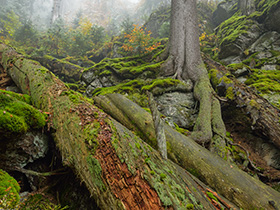
Is there an official National Park profile?
You can a good overview of Germany’s oldest national park – the Bavarian Forest National Park founded in 1970 – on our profile page
What are the missions and aims of the National Park?
The Bavarian Forest is a largely forested medium-range mountain landscape which is highly characteristic for Central Europe. The Bavarian Forest National Park has the task of preserving this valuable region as well as its natural and near-natural ecosystems as a place of natural heritage for current and future generations. In addition to nature conservation as its overarching goal, the National Park’s protected area is also intended to serve purposes of natural history education, offer academic insights, help people experience nature and promote structures within the region. You can find out more about this on our missions and aims page.
Is admission to the National Park free?
The Bavarian Forest National Park and its visitor facilities are free of charge to visit. However, a parking fee of a maximum of 5 euros per day is charged at the central car parks. A proportion of the funds generated by this is used to support the region’s local public transport network. In addition, an admission fee is also charged for the privately-operated tree top walk.
Rules in the protected area
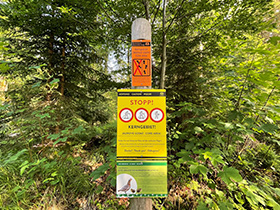
Do I have to stay on the trails in the National Park?
Over half of the National Park surface area, predominately in lower-lying areas, is freely accessible all year round. Visitors are only prohibited from leaving the trails in particularly sensitive parts of the National Park, such as high-level or peatland areas. As a result, visitors have to remain on the well-marked and extensive network of trails in around 45 percent of the National Park area. The only exception: In the period from 15 July to 15 November, "special paths and hikes" (old, unmarked trails) are opened up to the public. Clearly visible signs indicate what rules apply in each respective area of the Park.
Is it allowed to take pictures in the national park?
Everyone may take pictures and make videos within the Bavarian Forest National Park - for private use. Drones are prohibited in general. Photo and / or video recordings of the national park that are made for commercial purposes, require a photo and / or filming license. In order to get further information on this topic, see our press area at https://www.nationalpark-bayerischer-wald.bayern.de/ueber_uns/presse/index.htm
Are dogs allowed in the National Park?
Visitors can certainly bring their dogs with them on walks. There are however a few exceptions. Dogs are not allowed in the walkable sections of the animal enclosures at the Lusen National Park Centre as well as on the trail through the deer enclosure at Scheuereck. There are alternative routes available for dogs in these areas. Please note that dogs should remain on a lead if they don’t walk at heel. In addition, dogs are not permitted in the central visitor centres in the National Park, such as the Haus zur Wildnis and Hans-Eisenmann-Haus. Dog boxes are available here.
Can I dispose of dog waste bags in the National Park?
In three areas which are particularly popular with visitors, we offer dog waste disposal stations. These can be found in the Lusen and Falkenstein National Park Centres with their animal enclosures as well as in the forest playground near Spiegelau. In the remaining areas of the National Park, we are unable to provide dog waste disposal stations for logistical reasons. In these areas, please take your dog waste bags with you and dispose of them at home. Alternatively, the dog waste – without a bag – can be disposed of in the forest away from the trails.
Am I allowed to collect mushrooms and berries?
Visitors are permitted to collect mushrooms and berries for use at home. However, in line with the generally applicable legal regulations, any sale of the food collected in the forest is prohibited. In addition, we kindly request that you remain on the trails wherever requested.
Am I allowed to build a fire?
Open fires are prohibited in the National Park. Fires are only permitted in the four dedicated barbeque areas and hearths. Read our page on playgrounds and barbeque areas for more on the location of these sites. For groups of 15 or more people, the barbeque areas near Waldhäuser, Spiegelau and Mauth require a telephone reservation with the Hans-Eisenmann-Haus team ( 08558 9615-0), while the barbeque area near the Zwieslerwaldhaus requires a reservation with the Haus zur Wildnis team ( 09922 50020). There is no charge for this service.
Is it allowed to smoke in the woods?
You have to follow the existing regulations. According to Bavarian Forest Law, it is not allowed to smoke in the time of March 1st to October 31th. The risk of forest fires is too high in these months. Outside this time we ask our visitors to use the ballot bins, which are placed in our visitor centers, or a mobile ashtray. Cigarette stumps, who are carelessly thrown away, have negative consequences for nature. A single cigarette stump contains up to 4000 toxins and can contaminate 50 liters of water.
Are there any areas where swimming is permitted in the National Park?
Swimming is generally prohibited in the National Park. However, there are several lakes where swimming is permitted in the neighbouring region. You can get more information on this on the Ferienregion Nationalpark Bayerischer Wald website.
Is horse riding allowed in the National Park?
Horse riding is not permitted according to the National Park Regulation. Riding is only possible on a small connecting bridleway between Spiegelau and Klingenbrunn/Station.
Our rangers
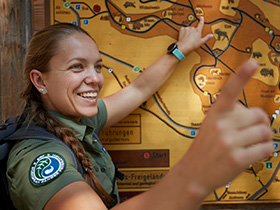
What does a park ranger do?
First and foremost, the National Park authority staff are the first point of contact for visitors to the region. They can provide tips for your visit, explain the sensitivity of the natural world in the protected area and answer any questions from visitors. In addition, the rangers also regularly offer tours to the public. One of their most important tasks is also surveillance, ensuring compliance with the rules of the national park. They also provide input for public relations, research and route management.
What powers do rangers have?
The staff of the National Park ranger service are equipped with police powers. Visitors are therefore obliged to identify themselves at the request of rangers to provide their personal details. Rangers are also permitted to issue expulsions.
How are violations of the rules punished?
If rangers identify violations of applicable protective regulations, like straying away from marked trails in winter and spring, administrative offence proceedings are usually initiated with the responsible district authorities. The type of violation and personal details of the offender are provided by the rangers in these cases. The administrative bodies then determine the fine. In the event of infringements in the field of road traffic, like driving on closed roads, the responsible police departments are informed, which then in turn initiate administrative offence proceedings.
National park nature
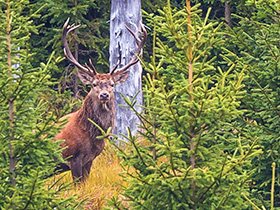
What types of landscapes are found in the National Park?
The National Park is around 98 percent forest. This includes mixed mountain forests, mountain spruce forests and alluvial spruce forests. In addition, the Bavarian Forest National Park also contains peatland, open rock faces and historic high-level pastures known locally as “Schachten”. You can read more about the different types of landscape found here in the habitats section.
What animals live in the National Park?
The National Park is home to thousands of species. Some 3849 animals have been officially documented to date. These include “flagship” species such as the capercaillie or the lynx as well as 15 types of beetle which are seen as relics of the pristine woodlands. In addition to diversity among animals, the biodiversity in lichens (344 species), mosses (488), vascular plants (757) and fungus (over 2000) is also extremely high.
What risks are connected to dead wood?
In the National Park, the aim is to protect the natural process of genesis, growth and decay. Dead trees are therefore left to return to the natural cycle here. As a result, falling trees and dead wood are typical hazards in our woodland. Please be aware of these dangers and leave the forest during strong winds for your own safety. Please be aware that you always use the trails in the National Park at your own risk!
How should I behave if I encounter a wolf?
If you encounter a wolf, you should show respect towards the animal. You shouldn’t walk away, but instead slowly withdraw. If, despite this, a wolf does come too close, you should draw attention to yourself, talk loudly, gesticulate or make a commotion in another way. Dogs should definitely be kept on a lead. You should not follow the wolf, offer it anything to eat or take photographs of it. You can get more information in the FAQ section of the State Office of the Environment website.
Hiking and cycling
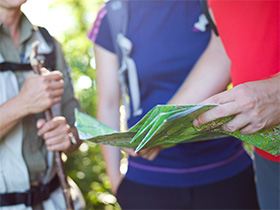
What types of walking trails exist in the National Park?
The Bavarian Forest National Park encompasses a marked network of walking trails measuring some 350 kilometres in total. There are essentially two different types of trails. If you follow circular routes, marked by an animal symbol against a yellow background, you will always return back to your starting point. In contrast, one-way routes, marked by a plant symbol against a white background, lead from A to B. In addition, the area also features several long-distance walking paths, such as the Goldsteig and the E6 European long distance path (marked with special respective symbols).
Is a map available which shows all walking paths?
An excellent map created in cooperation with the National Park is offered by the Ferienregion Nationalpark Bayerischer Wald organisation. The map can be purchased at the shops within the Lusen and Falkenstein National Park Centres as well as at the National Park information points. The regional map in our Discover Diversity brochure offers a more general overview of the trails in the Bavarian Forest National Park.
What is the general condition of the trails?
Our paths are checked on a regular basis and the flanking foliage is cut back whenever required. However, after widespread storms, this process can take a couple of weeks. The trail service page provides an up-to-date overview of the conditions on the trails in the National Park.
Are guided tours available?
The Bavarian Forest National Park offers a wide-ranging tour programme from 26 December to 8 November. Many of these tours lead visitors through particularly wild sections of our unspoilt region. All events are listed in our calendar as well as in the latest tour guide brochure, which is linked on the site of our calendar. Individual tours or group tours can be booked at the National Park guidance service. Call 0800 0776650.
Are cross-border tours into Šumava National Park possible?
The two neighbouring national parks work very closely together – including on the trail concept. As a result, cross-border tours are of course possible. The border crossings in Bayerisch Eisenstein, at the Zwieslerwaldhaus, at Gsenget and near Finsterau are open all year round. In addition, the border crossings at the Hirschbachschwelle and at the Lackabruck are open from 15 July to 15 November.
Where can I find walking trail recommendations?
We offer an interactive section with trail tips. This includes walking paths, tips for snowshoe routes and recommendations for disabled visitors.
Am I allowed to cycle everywhere in the National Park?
The Bavarian Forest National Park is synonymous with low-impact tourism. As a result, mountain bike routes which cut straight across the landscape are strictly prohibited. Nevertheless, cyclists will find a whole host of fascinating routes to explore in the National Park. A cycle trail network over 200 kilometres in length is well marked throughout the Park. Cycling is only permitted in the National Park on these clearly designated routes.
Winter sports
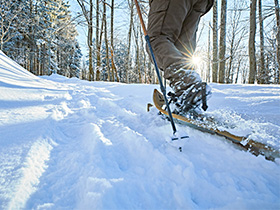
What about skiing?
Alpine skiing is not permitted in the National Park. However, there are great resorts on the edge of the National Park for enjoying skiing, particularly suited to beginners and families. You can get more information on this at Ferienregion Nationalpark Bayerischer Wald. (Cross-country skiing, in contrast, can be enjoyed on 80 kilometres of trails through the heart of the National Park.)
Where are the cross-country ski trails?
Around 80 kilometres of cross-country ski trails run through the National Park. Finsterau and Zwieslerwaldhaus are the two main hubs within the Nordic sports network. You can get more information on the trail network and current snow levels at Ferienregion Nationalpark Bayerischer Wald.
Is there anything special to consider for ski tours and snowshoe hikes?
The majority of marked trails are not cleared or groomed in winter. It is therefore advisable to only use said trails with snow shoes or cross-country skis if snow conditions dictate this. During the winter months, you are prohibited from leaving the marked trails. This measure is aimed at protecting endangered flora and fauna, such as the capercaillie. In addition, ensure you carry sufficient food and drink with you, as the mountain huts have limited opening hours in winter.
Bus, train and car
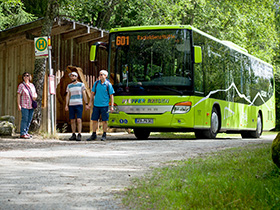
How can I get to the National Park by bus and train?
Four Waldbahn lines connect the dots in the National Park region, with Zwiesel forming the main hub in the heart of the area. From here, trains run to Plattling near Deggendorf, which is linked to the ICE high-speed rail network. Falkenstein National Park Centre in Ludwigsthal has its own small station on the Plattling – Bayerisch Eisenstein Waldbahn line, while the forest playground in Spiegelau is just a stone’s throw from the town’s station on the Zwiesel – Grafenau line. In the summer months, the Ilztalbahn runs from Passau Central Station (also on the ICE rail network) to Freyung at the weekends, offering an additional point of access to the National Park region. The rail connections are complemented by a connected bus network, the Igelbus service, which links all the important National Park facilities and trail heads. You can find timetable information at www.bayerwald-ticket.com.
Does the local public transport network effectively replace a car in the region?
All the important National Park facilities as well as trail heads are connected to the local public transport network during the main holiday periods. Guests staying in one of the region’s over 20 GUTi municipalities can even use local transport in the National Park region free of charge with the Gästeservice Umwelt-Ticket (GUTi). The Bayerwald-Ticket is a good-value alternative for day trippers. Find out more at www.bayerwald-ticket.com.
Are the roads in the National Park accessible to cars at all times?
The public road system within the National Park is freely accessible by car all year round. There are only four sections of road within the National Park interior where special regulations apply:
- The access road to the Waldhausreibe at the foot of Lusen from Waldhäuser (Lusenstraße) and from the Lusen National Park Centre (Böhmstraße): Only open for private traffic between 15 May and 31 October before 9 a.m. and after 4 p.m. These areas are served by the Igelbus service in the remaining periods. Closed completely between 1 November and 14 May.
- Access road to the Gfäll car park below Rachel from Spiegelau: Only open for private traffic between 15 May and 31 October before 8 a.m. and after 6 p.m. These areas are served by the Igelbus service in the remaining periods. Conditional accessibility between 1 November and 14 May as only limited snow clearance work and gritting is carried out here. Snow chains may be required.
- Access road to the Racheldiensthütte from the Racheldiensthütte car park on the Nationalparkstraße: Only open for private traffic between 15 May and 31 October before 8 a.m. and after 6 p.m. This area is served by the Igelbus service in the remaining periods. Closed completely between 1 November and 14 May.
- Access road to the Buchwald border crossing from the Wistlberg car park near Finsterau: Only open for private traffic between 15 May and 31 October before 9 a.m. and after 6 p.m. This area is served by the Igelbus service in the remaining periods. Closed completely between 1 November and 14 May.
National Park Facilities
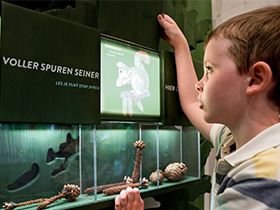
What visitor facilities does the National Park offer?
The Bavarian Forest National Park offers visitors two main visitor centres. The Falkenstein National Park Centre with the Haus zur Wildnis, animal enclosures and stone age cave near Ludwigsthal in Regen county, and the Lusen National Park Centre with the Hans-Eisenmann-Haus, animal enclosures, botanical site, geological site and tree top walk near Neuschönau in Freyung-Grafenau county. In addition, visitors can also enjoy the Forest History Museum St. Oswald, the forest playground near Spiegelau and six additional information points. Admission to and use of all facilities is free and mostly accessible for disabled visitors.
When are the main visitor centres open?
Visit the following pages to find out the exact opening hours of our museums:
How do I get to the tree top walk?
The tree top walk is part of the Lusen National Park Centre. You can find out everything you need to know about this attraction on the website of its operator Erlebnis Akademie AG.
Is there anything special to consider when visiting the animal enclosures?
The animal enclosures near Ludwigsthal and Neuschönau were established as a place of leisure for visitors and a source of useful information about the National Park and domestic fauna. In order to make your visit as pleasant as possible and ensure that any disturbance to the animals is kept to a minimum, there are several rules to remember. The following activities are not permitted in the animal enclosures:
- Littering the site including the aviaries and enclosures
- Intentionally disturbing or feeding the animals in the enclosures
- Climbing onto railings or leaving marked trails
- Cycling, riding or leading horses on the trails
- Allowing dogs to roam off the lead or swim in bodies of water
- Smoking or making an open fire
- Making noise, using drones, audio and video recording equipment and musical instruments
- Using flash photography or film lamps in the area around the enclosures and aviaries
- Filming or photographing for commercial purposes, unless written permission to do so has been provided by the National Park Administration (application form for photo and/or video authorisation)
- Holding organised events and photo workshops, unless written permission to do so has been provided by the National Park Administration
Is there an offering tailored for school classes and other groups of children?
The National Park offers a wide-ranging environmental education programme for schools, kindergartens and other children’s groups. You can find out all about this here: the forest as a place of learning.
Traveling with children
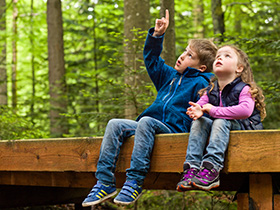
Are the walking and cycle trails in the National Park suitable for children?
In general, all trails in the National Park are suitable for children and young people with a good level of basic fitness. There are only a few areas – mostly on the mountain peaks – where there is a hazard of falling, and additional caution is advised in these areas. The flatter trails in lower-lying areas are more suited to young children who are unable to walk long distances – as are the circular routes in the animal enclosures at Neuschönau and Ludwigsthal as well as in the forest playground near Spiegelau.
Which trails are suitable for buggies?
Some parts of our trail network, particularly in lower-lying areas around the local towns as well as in the animal enclosures at Neuschönau and Ludwigsthal and the forest playground near Spiegelau are suitable for buggies. In contrast, the often narrow, stony trails – particularly at higher levels – are not suited to buggies.
Are there any play areas in the National Park?
One extensive and well-maintained play area is provided by the National Park at the forest playground near Spiegelau. See our playgrounds and barbeque areas page for information on additional play areas.
Does the National Park offer special events for children?
The tour programme offers regular events for children and young people. Additional events are also provided during the Bavarian school holidays. You can find out more about these in our events calendar. In addition, we also offer the option of holding children’s birthdays here.
Are the National Park centres suitable for children?
The Hans-Eisenmann-Haus, the Haus zur Wildnis and the Forest History Museum are geared up to the needs of children. There are therefore plenty of play areas here and the information content is often presented in a child-friendly way. In addition, our facilities also offer special children’s routes which allow young visitors to discover our exhibitions interactively.
Stay overnight and stop off
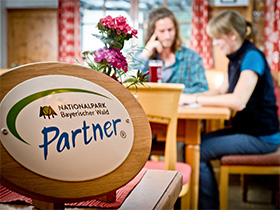
Where can I stay
The Bavarian Forest National Park does not provide any accommodation for tourists. However, the Park works closely with its National Park Partners to offer this. These partners are businesses, mainly in the hotel trade, which have entered into a close cooperation with the National Park and boast sound knowledge of the region. We can warmly recommend all of these partners.
Is camping permitted in the National Park?
No. Wild camping is prohibited in the natural environment of the Bavarian Forest National Park – as it is in the Alps. Campsites are however available in directly neighbouring areas. Find out more at Ferienregion Nationalpark Bayerischer Wald. In addition, youth groups can also use the National Park’s youth camp site near Forstwald.
Are there any camper van parking pitches in the National Park?
The National Park offers camper van parking pitches in Scheuereck and at the parking spot of the Falkenstein National Park Centre near Ludwigsthal. Information on booking can be obtained from the staff of the Haus zur Wildnis: +49 9922 5002-0 or hzw@npv-bw.bayern.de. In the immediate vicinity of the protected area there are other offers for mobile homes and caravans. You can find information on this at the Ferienregion Nationalpark Bayerischer Wald.
Does the National Park feature any mountain huts serving food and drink?
The three main peaks in the National Park all feature mountain huts with full opening hours throughout the summer months and limited opening hours in winter: The Lusenschutzhaus located just below the peak of Lusen, the Waldschmidthaus on Großer Rachel (only opened in the summer months - daily from 10 a.m. to 5 p.m.) and the Falkensteinschutzhaus directly on top of Große Falkenstein. The Racheldiensthütte at the foot of Rachel, below Rachelsee, is also open daily from May to October from 9:30 a.m. to 6 p.m. In addition, the Trifterklause Schwellhäusl is also located in the National Park, between Zwieslerwaldhaus and Bayerisch Eisenstein. Moreover, the National Park enclaves of Waldhäuser and Zwieslerwaldhaus offer plenty in the way of food and drink, as do most of the towns along the edge of the National Park. The National Park centres at Lusen and Falkenstein also serve food and drink.
Accessibility
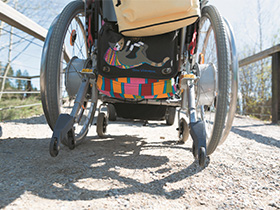
Are the trails in the National Park suitable for wheelchairs?
The Bavarian Forest National Park is a mid-range upland area with some steep inclines and narrow, stony paths. As a result, the majority of our trails are not suitable for wheelchairs. However, in areas close to towns, we have made several trails accessible with assistance , such as those in our animal enclosures in Neuschönau and Ludwigsthal or in the forest playground near Spiegelau. Recommendations for routes accessible with assistance are provided in our trail tips section.
Are the visitor facilities universally accessible?
The Hans-Eisenmann-Haus, the Haus zur Wildnis and Forest History Museum are considered partially accessible . This means that all the main points of the exhibitions, eateries and bathroom facilities are universally accessible and wheelchair-friendly. Paths which are well marked and accessible with assistance are also offered at the forest playground near Spiegelau, in the animal enclosures near Neuschönau and Ludwigsthal as well as at the botanical and geological sites. Many of these locations have already been officially certified as “accessible with assistance ”.
Is it possible to rent wheelchairs for use in the National Park?
Wheelchairs for use at our facilities are available at the Hans-Eisenmann-Haus, Haus zur Wildnis and Forest History Museum. For use on trails, the car park service at the Lusen National Park Centre offers the option to rent electric, folding and all-terrain wheelchairs. For inquiries, please call 08558 9729823. All services are offered free of charge.
Are special tours offered for disabled people?
We are happy to offer free tours for people with physical or mental disabilities, providing participants with an in-depth experience of the forest and wilderness. We are happy to deliver on any specific requirements wherever possible. Please get in touch with us at least two weeks before your planned visit: 09922 5002-0 or npfueralle@npv-bw.bayern.de.
Management in the protected area
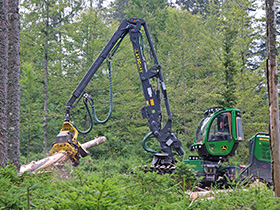
What is the difference between the “natural zone” and the “core area”?
Natural zones are areas of the National Park where there is no human interference. The motto "Letting nature be natural" applies here to its fullest extent. By 2027, the proportion of natural zones in the Bavarian Forest National Park will grow to 75 percent and therefore fulfil the internationally-required standard. In contrast, the core zone includes any areas containing particularly sensitive habitats and species, such as the capercaillie. These include high-level areas or bogs in the National Park. Visitors are not permitted to leave marked trails in the core zone with a view to protecting these endangered species. The only exception: Old historical trails which are no longer marked are also freely accessible between 15 July and 15 November. The current zoning map can be found here.
What is the situation with bark beetle infestations and windthrow?
In the National Park, the aim is to protect the natural process of genesis, growth and decay. This also includes allowing trees felled by storms or bark beetles to remain part of the natural cycle. This not only offers extra light into forested areas, it also adds valuable structure to the forest. As a result, many sometimes highly endangered species can enjoy improved living conditions and/or more abundant sources of food. The gaps in the canopy also ensure that the next generation of forest flora can develop according to its own ancient laws – in turn allowing the pristine forest of tomorrow to emerge.
Why are there no rubbish bins in the National Park?
With a handful of exceptions, there are no rubbish bins in the Bavarian Forest National Park. This concept is based on the experience that rubbish generally creates more rubbish. In addition, maintaining rubbish bins would create high costs for disposal. From an environmental point of view, it does not make sense to collect mixed waste in rubbish bins as this makes the process of separate recycling impossible. We therefore kindly request that you take your litter home with you and refrain from leaving it in the National Park. This includes dog waste bags and tissues. Please help us to keep our wild woodland clean. Thank you!
Are animals hunted and trees felled in the National Park?
No human interference of any kind takes place in the natural zones, so there is no hunting of animals or felling of trees here. In the zones at the limits of the National Park, there are bark beetle management zones aimed at protecting neighbouring private forests. This means that spruce trees felled by bark beetles are removed here. Hunting also takes place at times in these same areas. This influences the population of wild boars and red deer, but any hunting of roe deer and other huntable species has been completely discontinued.
Is the National Park important for the public drinking water supply?
The streams which spring in the Bavarian Forest National Park provide large swathes of Lower Bavaria and Upper Palatinate with clean drinking water. Most of this water is sourced from the drinking water reservoir near Frauenau, which was set up in 1983 and directly borders the National Park. The quality of the water has been intensively inspected by experts for decades. All studies have shown that the concept of "Letting nature be natural" is unquestionably compatible with the high quality standards required for drinking water from the Bavarian Forest.

